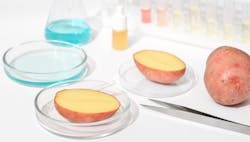The Petri dish may owe its debut to problematic potatoes.
When German microbiologist Julius Petri joined Robert Koch in a Berlin research facility in the 1870s, lab assistants were growing bacteria in liquid broth. Koch, now recognized as one of the founding fathers of microbiology, realized the benefits of developing a solid culture media and began growing bacteria on slices of potatoes.
Not surprisingly, the handling and storage of potatoes proved somewhat impractical in the lab — and a few modifications and iterations later, the Petri dish was born.
As far as scientific innovations go, the Petri dish may leave a little to be desired in the ‘glitz and glamour’ category, but no one can argue its staying power. Over 130 years later, millions of these shallow, transparent, lidded dishes continue to be utilized in labs on a daily basis. Despite being used and then discarded without much thought, Petri dishes are relied on to produce a constant supply of microorganisms. They’ve been around for all the major scientific discoveries throughout history. For scientists, they are vital to getting the job done.
But what happens when something you depend on simply isn’t there? The pandemic answered that question for many industries, and plastic lab supplies were no exception.
With lab tests in high demand and supplies back ordered for months, labs started scrambling for basics like pipettes and Petri dishes. While bigger labs threw their weight around to get priority, smaller labs hoarded what they had and even started bartering for supplies with other labs.
While the lack of basic supplies is a hindrance to progress, the lack of people to use those supplies is arguably worse. And the biopharma industry knows this scenario all too well. For the past two decades, biopharma has been booming, largely propped up by the success of mAbs. But with that growth has come a shortage of something the broader pharma industry had at times taken for granted — skilled labor.
As you will read in this month’s cover story, the cell and gene therapy sector is busy carving out its own very important niche within the biopharma industry. There are now more than 1,000 CGT developers around the world — and more than half of them are in the U.S. Collectively, these organizations have more than 3,500 cell and gene therapies in development.
If the sector continues to grow as projected (at an annual rate of 40%!), the industry will need a steady supply of well-trained talent poised to manufacture tomorrow’s lifesaving therapies. In some ways, the sector is preemptively scrambling to solve a problem that isn’t quite laid out yet. The CGT field is still comparatively nascent, the workforce is not strictly defined, and labor market research specific to CGT is hard to come by.
Taking a cue from biopharma’s ongoing struggles, the CGT industry has begun embracing new ways of cultivating experience — through opportunities like apprenticeships or two-year training programs. Importantly, the sector is realizing that the talent supply isn’t a given — it has to be grown. Forward-thinking companies are putting the tools in place to create a self-sustained talent ecosystem, where companies have their own in-house educational system.
With its potential to treat — and possibly even cure — devastating disease, CGT represents some of the most cutting-edge science the world has ever seen. But without a reliable way of culturing talent, industry progress could go the way of Koch’s potato.
About the Author
Karen P. Langhauser
Chief Content Director, Pharma Manufacturing
Karen currently serves as Pharma Manufacturing's chief content director.
Now having dedicated her entire career to b2b journalism, Karen got her start writing for Food Manufacturing magazine. She made the decision to trade food for drugs in 2013, when she joined Putman Media as the digital content manager for Pharma Manufacturing, later taking the helm on the brand in 2016.
As an award-winning journalist with 20+ years experience writing in the manufacturing space, Karen passionately believes that b2b content does not have to suck. As the content director, her ongoing mission has been to keep Pharma Manufacturing's editorial look, tone and content fresh and accessible.
Karen graduated with honors from Bucknell University, where she majored in English and played Division 1 softball for the Bison. Happily living in NJ's famed Asbury Park, Karen is a retired Garden State Rollergirl, known to the roller derby community as the 'Predator-in-Chief.'
